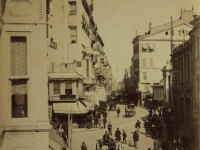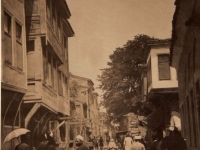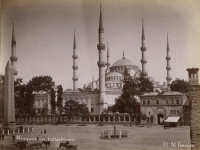Details regarding Mihran Iranian’s life and career are scant. It is known that he established his studio in 1891 in Pera district of Constantinople – the center of Armenian cultural and political life. In 1895 he enters into partnership with another photographer by the name of Gugasyan. By 1900s the business seems to have wound down as the images marked with his studio signature don’t exhibit any over elements of the new century. Of all the major Armenian studios from Istanbul, Iranian’s photographs are the rarest and less than 300 are known to have survived.
Iranian’s primary subject was the city of Constantinople, its picturesque landscape, architectural heritage and the many types of artisans and workers that populated its streets. Using the latest photography techniques, which allowed for very rapid exposures, Iranian captured the bustle of the city streets with remarkable clarity. Teeming with life and movement these images have a remarkable immediacy and documentary veracity quite unlike similar views produced by other photographers of the period.
The typical approach for many of Iranian’s contemporaries such as Sebah & Joalier or Guillame Berggren was to achieve as clear a picture as possible with perfectly balanced compositions and highly visible details – the hallmark of a ‘good’ commercial photographer. In contrast, Iranian’s street views are full of photographic ‘ruptures’ – blurred figures in movement, surprised glances of people caught unawares – which give his works the viscerality of snapshots. But above all, Iranian was a master at capturing the mood of a place. Catching the Ottoman capital on the brink of rapid transformation, the photographer aimed to record many of its ancient streets and quarters disappear or change appearance. Thus, like the Parisian street photography of Atget, Iranian’s images are ‘nostalgic for the present’ that is irrevocably slipping into the past. In his studio, the clientele had the choice of a large range of costumes and props through which the modern urbanite could slip into the role of some long-gone ethnic or street type and become a part of history.
It is this sense of melancholy that gives Iranian’s photographs their subtle emotional power. This is also perhaps the reason why he was ultimately not successful as a commercial photographer. Modernity had captured the imagination of the people and the wistful romanticism of Iranian’s markedly less spectacular images was fast going out of fashion. The small legacy he has left behind is nevertheless of significance in the history of Near-Easter photography. He was one of the rare Ottoman photographers with an individual and subjective approach, which deserves a proper evaluation.
BIBLIOGRAPHY:
Hoda Makram-Ebeid, ‘Mihran Iranian’ in Djamila Chakour & Mona Khazindar (eds), L’Orient des photographes Armeniens, Institut du Monde Arabe, Editions cercle d’art, Paris, 2007, p.







